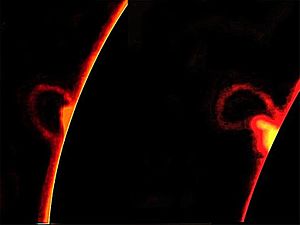Sunspots:Sunspots are said to be the coolest parts of the sun. Indeed, they are. Their temperatures range between 2,727–4,227 °C. These are actually phenomenons on the photosphere of the sun. They appear black against the background. They are caused by intense magnetic field which are like Eddy currents and thus form reduced surface temperature. The sunspots move around the sun in a cycle of 11 years called the Sunspot cycle. Every 11 years the sunspots increase and decrease. They appear they most on 6th year and thus large number of sunspots are seen. The are the least every 1st and 11th year.
 Solar Flares: Solar flares are tremendous explosions on the surface of the Sun. In a matter of just a few minutes they heat material to many millions of degrees and release as much energy as a billion megatons of TNT. They occur near sunspots, usually along the dividing line (neutral line) between areas of oppositely directed magnetic fields. It releases as much as 6 × 1025 joules of energy.
Solar Flares: Solar flares are tremendous explosions on the surface of the Sun. In a matter of just a few minutes they heat material to many millions of degrees and release as much energy as a billion megatons of TNT. They occur near sunspots, usually along the dividing line (neutral line) between areas of oppositely directed magnetic fields. It releases as much as 6 × 1025 joules of energy.
The Solar Flares heat up the plasma also to over 10 million Kelvin. These can some times lead to Solar winds or popularly called Coronal Mass Ejections(CME). Flares occur around the sunspots due to intense magnetic fluxes. These Flares are also helped by the magnetic Fields which are stored in the Corona.
Scientific research has shown that the phenomenon of magnetic reconnection is responsible for solar flares. Magnetic reconnection is the name given to the rearrangement of magnetic lines of force when two oppositely directed magnetic fields are brought together. This rearrangement is accompanied with a sudden release of energy stored in the original oppositely directed fields.
Solar Flares are classified as
Solar wind:
 Solar Flares: Solar flares are tremendous explosions on the surface of the Sun. In a matter of just a few minutes they heat material to many millions of degrees and release as much energy as a billion megatons of TNT. They occur near sunspots, usually along the dividing line (neutral line) between areas of oppositely directed magnetic fields. It releases as much as 6 × 1025 joules of energy.
Solar Flares: Solar flares are tremendous explosions on the surface of the Sun. In a matter of just a few minutes they heat material to many millions of degrees and release as much energy as a billion megatons of TNT. They occur near sunspots, usually along the dividing line (neutral line) between areas of oppositely directed magnetic fields. It releases as much as 6 × 1025 joules of energy. The Solar Flares heat up the plasma also to over 10 million Kelvin. These can some times lead to Solar winds or popularly called Coronal Mass Ejections(CME). Flares occur around the sunspots due to intense magnetic fluxes. These Flares are also helped by the magnetic Fields which are stored in the Corona.
 |
| A Solar Flare |
Solar Flares are classified as
- A
- B
- C
- M and
- X
 |
| Northern Lights |
- Northern Hemisphere - Aurora Borealis or Northern light
- Southern Hemisphere - Aurora Australis or Southern light
The solar wind is a stream of charged particles ejected from the upper atmosphere of the Sun. It mostly consists of electrons and protons with energies usually between 10 and 100 keV. The stream of particles varies in temperature and speed over time. These particles can escape the Sun's gravity because of their high kinetic energy and the high temperature of the corona.
The solar wind creates the heliosphere, a vast bubble in the interstellar medium that surrounds the solar system. Other phenomena include geomagnetic storms that can knock out power grids on Earth, the aurorae (northern and southern lights), and the plasma tails of comets that always point away from the Sun.









0 comments:
Post a Comment